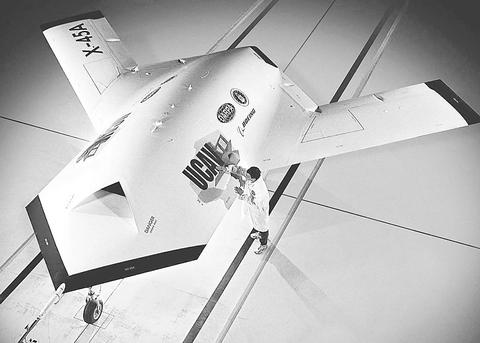Last fall, when Boeing's bid to build the F-35 Joint Strike Fighter flamed out and the US$200 billion winner-take-all contract to supply up to 3,000 planes went to its rival, Lockheed Martin, a good part of Boeing's plans went up in smoke.
Designed for the Air Force, the Navy and the Marines, the F-35 will be the last new manned American fighter for decades to come.
But, as things turned out, Boeing's warplane operations were set back only momentarily. The company is moving on to the next generation of combat planes: robotic, pilotless aircraft.

PHOTO: NY TIMES
Early this summer, the first test flight of Boeing's X-45 strike aircraft, with no pilot aboard, will take to the skies over Southern California. Far more sophisticated than the Predator surveillance planes flying over Afghanistan, the X-45 is being designed as a full-fledged attack plane. When called to duty, swarms of them would strike deep into enemy territory to knock out anti-aircraft sensors and missile batteries. The highly risky mission would clear a path for aircraft with pilots, saving them from danger.
If the X-45 works -- and it will take six years to find out -- there is no reason that it could not do the work of other manned-fighter missions, taking some of those 3,000 orders away from Lockheed Martin. The X-45 is a lot cheaper: Boeing is aiming to build and operate the robot fighter at one-third the cost of the F-35.
While pilotless aircraft are not new, the idea that a robot plane could replace an Air Force fighter pilot was, until recently, the stuff of futurist science magazines.
"Five years ago, people said it was ridiculous," said Michael Heinz, who heads Boeing's Unmanned Systems unit, created last November. But rapid advances in computer and communications technology, combined with the success of the Predator surveillance aircraft in Afghanistan, have turned battlefield commanders into true believers. In the process, a significant new market is being created within the military industry.
Frost & Sullivan, a research group in San Antonio, forecasts that the market for UAVs, or unmanned aerial vehicles, will be worth nearly US$5 billion by 2005. Heinz and other executives at military contractors see an annual market of at least US$10 billion by decade's end, with growth continuing at double-digit rates for a decade or more.
No one expects robotic aircraft to make up for Boeing's woes in the commercial aircraft business or for immediate cutbacks threatened for the F/A-18 Hornet for the Navy. Still, Heinz sees the UAV program as potentially huge: "What defines a huge business for Boeing? We're a US$58 billion business. A billion in revenue qualifies."
But Heinz wants a lot more than that. A Pentagon planning document called Joint Vision 2020 forecasts that one-third of the military's combat planes by that year will be robotic.
Military contractors also have their eyes on civil and commercial markets. If the Federal Aviation Administration certifies the plane -- a lengthy process, with no sure results -- contractors envision UAVs monitoring the skies of America in the name of domestic security.
Robopilot
Aviation consultants say they cannot imagine the government or the public accepting pilotless commercial airline travel -- even though computers have taken over large pieces of commercial pilots' tasks. But robotic planes are becoming progressively better at takeoff and landing, and the idea of pilotless FedEx and UPS transoceanic flights is technically plausible by the end of the decade.
Robot cargo planes could eventually bolster Boeing's commercial aircraft line, which is suffering from cutbacks in orders since Sept. 11. "We want to lead the transformation across the entire UAV spectrum: solutions for military, civil, commercial," Heinz said.
That is an ambitious goal for a company that is effectively a start-up in a field that has plenty of competition.
Already in the business are giants like Northrop Grumman -- which has a long history in UAV development through its purchase of Ryan Aeronautical -- as well as many smaller companies. Dozens of UAVs, in a variety of sizes and shapes, are in development. They include fantastical palm-size, insectlike fliers bearing tiny spy cameras; small helicopters that could airlift a wounded soldier; and full-size armed warplanes like the X-45.
Some are in use and have proved themselves in battle. The Cessna-size Predator, built by General Atomics Aeronautical Systems, is fitted with radar, infrared and video sensors and armed with Hellfire missiles. The Global Hawk, a 11.8 tonne surveillance plane, can cross oceans without refueling or loiter for 36 hours at 20,000m above a battlefield -- well out of the range of most anti-aircraft missiles. The Global Hawk, also deployed in Afghanistan, is built by Northrop Grumman as a replacement for the U-2 spy plane.
Success over Afghanistan has spread enthusiasm in the military for robotic aircraft. General Tommy Franks, commander of the military operation in Afghanistan, has called the Predator "my No. 1 sensor for tracking down al-Qaida," according to Lieutenant Colonel Douglas Boone, the Air Force officer in charge of acquiring spy planes. President Bush took special note of UAVs in his State of the Union address. Members of the Senate Armed Services Committee have indicated they are willing to spend more than the US$1 billion the Pentagon is seeking in the 2003 budget.
That does not surprise John Pike, director of GlobalSecurity.org and a longtime critic of profligate military spending. Although he warned that much can go wrong in future development, UAVs are proving themselves so far. "They're cheap, and they work," he said.
Live and in color!
Battlefield commanders, accustomed to waiting hours, sometimes days, for the results of reconnaissance missions, now receive airborne battlefield views instantly on color monitors. "It's like watching OJ in the white Bronco," Pike said.
Of course, the Pentagon has publicly exaggerated the performance of some weapons -- most notably during the Persian Gulf War, when the military boasted about high success rates for the Patriot missile against Iraqi Scuds. Later studies showed the Patriot did not perform nearly as well as the Pentagon had said.
Even so, production of the US$4.5 million Predator will triple this year, to a total of 24, supplementing the 75 that the government now has on hand, said Thomas Cassidy, the chief executive of General Atomics Aeronautical Systems. In addition, the Air Force plans to acquire six models of a new plane, the Predator B, which can fly at 14,000M, almost twice as high as the original Predator, making it less vulnerable to enemy fire. Boone expects to lose about 14 Predators a year from anti-aircraft fire, operator error or systems failure.
The Air Force will buy seven more Global Hawks at US$35 million each over the next two years, then start buying six a year. That will supplement the current fleet of three Hawks, which were rushed out of development for Afghanistan. One was destroyed in a crash landing at the end of last year in what the Air Force will only describe as a mechanical failure. Global Hawk flights were suspended while the accident was investigated, but by the middle of this month the Hawk was redeployed.
Robotic planes have seen action before. In Vietnam, drone aircraft -- far cruder than today's models -- flew more than 3,000 missions. Most were on surveillance and reconnaissance, though a few were equipped to fire Maverick missiles. After Vietnam, military spending wound down, and the Air Force put its resources behind the then-new F-15 fighter. Development of robotic aircraft all but stopped at the Pentagon until the 1990s, when military planners began turning their attention to "networkcentric" warfare, the move to tie battlefield weapons, computers and communications systems into a seamless data web.
The same forces that swept through commercial technology in the 1990s were also transforming weaponry and military communications. Computers, bombs, sensors and UAVs became smaller, smarter, lighter and faster. Pilotless aircraft, loaded with computer intelligence and fast communication links, came to be regarded as essential, airborne nodes on the battlefield information network.
In fact, the major military contractors view such aircraft as just one piece of a big market in networkcentric warfare -- currently valued by Frost & Sullivan at US$11 billion annually.
Heinz, of Boeing, regards his new group as "a new business unit that would focus the various efforts we have going on all across Boeing" in networkcentric warfare. "We called ourselves unmanned systems, not unmanned air vehicles," he said. "It's mission management, it's integration with the surveillance and reconnaissance systems."

The US dollar was trading at NT$29.7 at 10am today on the Taipei Foreign Exchange, as the New Taiwan dollar gained NT$1.364 from the previous close last week. The NT dollar continued to rise today, after surging 3.07 percent on Friday. After opening at NT$30.91, the NT dollar gained more than NT$1 in just 15 minutes, briefly passing the NT$30 mark. Before the US Department of the Treasury's semi-annual currency report came out, expectations that the NT dollar would keep rising were already building. The NT dollar on Friday closed at NT$31.064, up by NT$0.953 — a 3.07 percent single-day gain. Today,

‘SHORT TERM’: The local currency would likely remain strong in the near term, driven by anticipated US trade pressure, capital inflows and expectations of a US Fed rate cut The US dollar is expected to fall below NT$30 in the near term, as traders anticipate increased pressure from Washington for Taiwan to allow the New Taiwan dollar to appreciate, Cathay United Bank (國泰世華銀行) chief economist Lin Chi-chao (林啟超) said. Following a sharp drop in the greenback against the NT dollar on Friday, Lin told the Central News Agency that the local currency is likely to remain strong in the short term, driven in part by market psychology surrounding anticipated US policy pressure. On Friday, the US dollar fell NT$0.953, or 3.07 percent, closing at NT$31.064 — its lowest level since Jan.

The New Taiwan dollar and Taiwanese stocks surged on signs that trade tensions between the world’s top two economies might start easing and as US tech earnings boosted the outlook of the nation’s semiconductor exports. The NT dollar strengthened as much as 3.8 percent versus the US dollar to 30.815, the biggest intraday gain since January 2011, closing at NT$31.064. The benchmark TAIEX jumped 2.73 percent to outperform the region’s equity gauges. Outlook for global trade improved after China said it is assessing possible trade talks with the US, providing a boost for the nation’s currency and shares. As the NT dollar

The Financial Supervisory Commission (FSC) yesterday met with some of the nation’s largest insurance companies as a skyrocketing New Taiwan dollar piles pressure on their hundreds of billions of dollars in US bond investments. The commission has asked some life insurance firms, among the biggest Asian holders of US debt, to discuss how the rapidly strengthening NT dollar has impacted their operations, people familiar with the matter said. The meeting took place as the NT dollar jumped as much as 5 percent yesterday, its biggest intraday gain in more than three decades. The local currency surged as exporters rushed to